EDUCATION
Paper – II
Note : This paper contains fifty (50) objective type questions of two (2) marks each. All questions are compulsory.
1. Select a proper combination for the answer.
The study of philosophy by a teacher helps him/her.
i. learn the concepts of education easily
ii. think in a holistic perspective
iii. take a logical view of the world and reality
iv. attain confidence in planning how to teach
v. develop a critical framework
Codes :
(1) i, ii, iv and v
(2) i, ii, iii and v
(3) ii, iii, iv and v
(4) ii, iii and v
2. The reality is in the constant flux, hence knowledge is essentially relative in nature. Who among the following educators will favour this proposition ?
(1) Immanuel Kant
(2) John Dewey
(3) David Hume
(4) Leibnitz
3. Which of the following statements finds support from an existentialist teacher ?
(1) Education is value centric.
(2) Education is instinctive.
(3) Education is contextual.
(4) Education is perennial.
4. Which of the following schools of philosophy regards education as a means for social growth and economic production ?
(1) Idealism
(2) Realism
(3) Naturalism
(4) Marxism
5. In the framework of Sankhya stipulation, which of the following will not be considered acceptable ?
(1) Prakriti is trigunatmak.
(2) Prakriti is subtle.
(3) Prakriti is directly visible.
(4) Prakriti is by nature evolutionary.
6. Which Indian school of thought considers all knowledge as relative ?
(1) Buddhism
(2) Vedant
(3) Jainism
(4) Islam
7. Match the items of List-I with that of List-II and select the appropriate code :

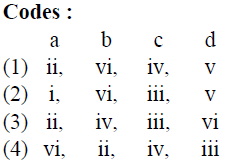
8. Which of the following core content will not conform to Gandhiji’s views ?
(1) Language
(2) Social studies
(3) Vocational skills
(4) Genetic Engineering
9. Which of the following constitutional values gets endorsed through reservation policy in education ?
(1) Liberty
(2) Equality
(3) Fraternity
(4) Humanity
10. The main purpose of education should be the integrated development of the person. Who has offered a model in this regard ?
(1) Aurobindo
(2) Tagore
(3) Gandhi
(4) Vivekananda
11. Which combination of measures in the list given below is likely to ensure social equity and equality of educational opportunity ?
i. The education of girl child should be organized separately.
ii. Each child should be provided an opportunity to grow, develop and flourish.
iii. Education of tribal children should be given priority as against the non-tribals.
iv. Curriculum at the school level should be diversified to cater the diverse needs of students.
v. Moral education should form a part of every school curriculum.
vi. The multiplicity of methods and approaches should be emphasized in school systems.
Select the correct code :
Codes :
(1) i, ii and iii
(2) iv, v and ii
(3) ii, iv and vi
(4) iii, iv and v
12. In the following two sets, Set-I gives the specific disciplines while Set-II provides the major concerns of the disciplines. Match the two sets :

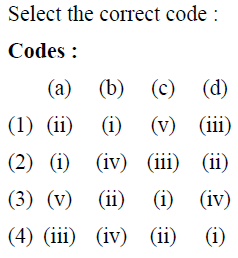
13. Role conflict and issues of collaboration are most relevant to which of the following disciplines ?
(1) Cultural Anthropology
(2) Educational Sociology
(3) Politics and Education
(4) Value based Education
14. According to educational sociologists the role of education should focus on
(1) Social integration among the groups
(2) Enculturation of participants in education
(3) Social mobility of the downtrodden
(4) Modification of values of teachers
15. Education is considered as a sub-system of a social system because :
(1) It provides essential service that society has to provide to the people.
(2) It has a complex structure.
(3) It has well defined objectives and functions to promote adaptations.
(4) It has various interacting components determining social goals.
16. Vertical mobility will be said to occur when :
(1) People move from rural area to urban area.
(2) People move from one social position to the other social position.
(3) People move from one position to the other superior position.
(4) People move from one place to the other place.
17. Which statement refers to the two way relationship between education and society ?
(1) The school is a miniature social system.
(2) The society plans to have schools.
(3) The school is a creature of society.
(4) The school is created by society to recreate itself.
18. The process of socialization is accelerated during adolescence through
(a) Family orientation
(b) Religious affiliation
(c) The school system
(d) The peer group interaction
(e) Neighbourhood hospitality
Choose the correct set of answers from the following codes :
Codes :
(1) (a) (b) (c)
(2) (b) (e) (a)
(3) (a) (c) (d)
(4) (c) (b) (e)
19. A school principal organizes a spectrum of co-curricular activities so that the maximum participation of students and teachers is ensured. Which of the following values will get optimally encouraged through such interventions ?
(1) Religious values
(2) Moral values
(3) Democratic values
(4) Scientific values
20. Changes in society which manifest ideas, values and literature may be called
(1) Non-material changes
(2) Ornamental changes
(3) Cosmopolitan changes
(4) Material changes
21. In the context of social development which of the following stages is characterized by ‘Intense self Awareness’ ?
1) Infancy
(2) Childhood
(3) Adolescence
(4) Adulthood
22. Which of the following is the characteristic feature of the emotional development during adolescence ?
(1) Jealously towards brothers / sisters in the family and peers in the school.
(2) Conflicts in motivations.
(3) Showing curiosity towards environmental objects.
(4) Tendency to evince worries in respect of school or personal related matters.
23. Which of the following subordinate laws of learning developed by Thorndike is related to classical conditioning of Pavlov ?
(1) Multiple response
(2) Prepotency of elements
(3) Associative shifting
(4) Response by analogy
24. Match the two sets by selecting the correct code :

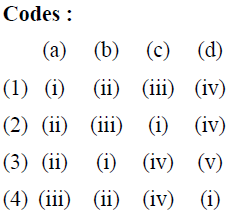
25. In the following two sets, Set-I gives the stages of cognitive development as given by Piaget and Set-II provides the important features which denote the cognitive growth.
Match the two by selecting the correct code :


26. In which of the following operant conditioning procedures the training arrangement insists the presence of a cue and making of a response to get negatively reinforced ?
(1) Escape training
(2) Punishment training
(3) Omission training
(4) Active avoidance training
27. Which of the following list reflects the basis for Tolman’s sign gestalt learning. Select from the code :
(i) Experiments on maze learning
(ii) Place learning experiment
(iii) Reward expectancy experiment
(iv) Habit family hierarchy
(v) Latent learning experiment
Code :
(1) (ii), (iv) and (v)
(2) (i), (ii) and (iii)
(3) (ii), (iii) and (v)
(4) (ii), (iii) and (iv)
28. In which of the following teaching-learning presentations, shaping of a response is called for ?
(1) Lecturing with examples
(2) Discussions with buzz sessions
(3) Programmed learning with individualisation
(4) PowerPoint presentation with a scope for interaction
29. In Skinner’s view secondary reinforces are derived when associated with
(1) Neutral stimulus
(2) Positive stimulus
(3) Negative stimulus
(4) Either positive or negative stimulus
30. Match the two sets and choose the correct answer from the code given :
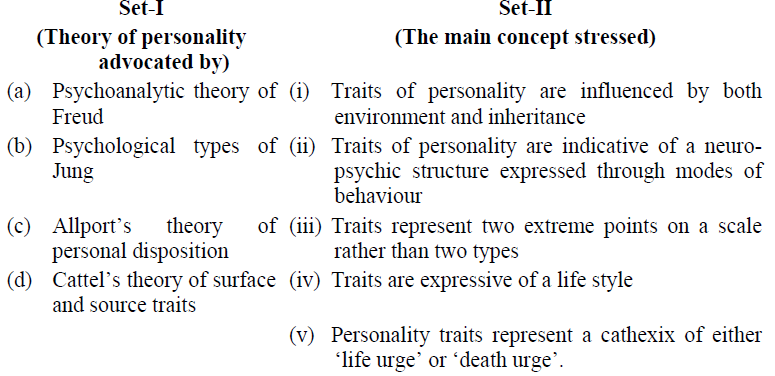
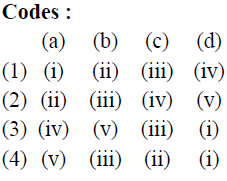
31. Brainstorming procedures are helpful specially for which category of children ?
(1) Gifted children
(2) Backward children
(3) Creative children
(4) Mentally retarded children
32. Which set of statements best describes the process of adjustment in the context of education ? Select the code for giving your answer :
(i) Adjustment is the outcome of the individual’s efforts to deal with stress.
(ii) Adjustment is directed at changing others.
(iii) For defining adjustment the reciprocal influence between a person and his/her social group has to be emphasized.
(iv) Adjustment is a continuous process of satisfying one’s needs.
(v) Adjustment is a kind of mentoring.
(vi) In adjustment both individual and his/her environment undergo a change.
Codes :
(1) (i), (iii), (iv) and (vi)
(2) (i), (ii), (iii) and (iv)
(3) (ii), (iii), (iv) and (v)
(4) (iii), (iv), (v) and (vi)
33. Match the two sets, Set-I theories of intelligence and Set-II the special emphasis given in explaining and measuring intelligence. Choose the correct code for indicating your answer:
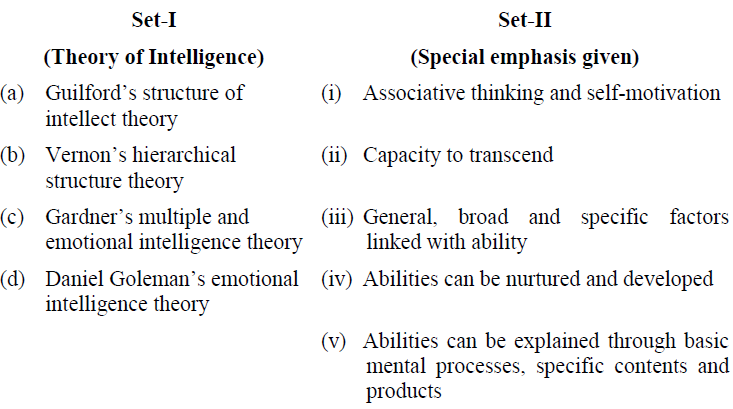
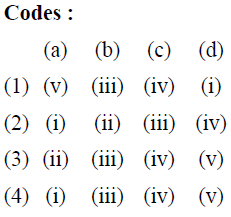
34. Which concept of intelligence addresses the problem of meaning and value ?
(1) Academic Intelligence (IQ)
(2) Emotional Intelligence (EQ)
(3) Spiritual Intelligence (SQ)
(4) Cultural Intelligence (CQ)
35. Assertion (A) : In order to be able to present learning materials in a systematic manner and to promote group learning a teacher’s IQ and EQ must be high.
Reason (R) : IQ of an individual contributes to being systematic while EQ helps in understanding group needs.
Which of the following options is correct ?
(1) Both (A) and (R) are true but (R) is not the correct reason for of (A).
(2) Both (A) and (R) are true, and (R) is the correct reason for of (A).
(3) Both (A) and (R) are false.
(4) (R) is true, but it cannot be the reason for (A).
36. Which of the following questions will belong to qualitative research ?
a. What is the impact of RTE Act on attendance of elementary school children ?
b. Why do parents not participate in PTA meetings ?
c. How to assess the competency level of school teachers ?
d. Why students of a particular community out number as dropouts ?
e. How to assess the verbal ability of elementary school children ?
Codes :
(1) a and d
(2) c and e
(3) d and e
(4) b and d
37. The methodology section in a quantitative research paradigm-based article contains
(1) Participants, materials, instruments
(2) Participants, procedures, materials
(3) Instruments, procedures, data analysis
(4) Participants, instruments, procedures
38. “_____ assesses the sufficiency of the data according to the convergence of multiple data sources or multiple data collection procedure.” Identify the term referred to above.
(1) Multivariate analysis
(2) Meta analysis
(3) Contexualization
(4) Triangulation
39. In educational research, case study method gives importance to :
(1) Prediction
(2) Causal connections
(3) Generalization
(4) Unique characteristics
40. Percentile scores assume a scale of measurement called
(1) Nominal scale
(2) Ordinal scale
(3) Interval scale
(4) Ratio scale
41. The purpose of methodology section of qualitative studies is to
(1) show how researcher interpretations will be made
(2) present the focus of the study
(3) provide general background of the study
(4) describe the overall design of the study
42. Internal reliability in qualitative research design refers to
(1) Information selection
(2) Inter observer reliability
(3) Extent to which the results approximate the reality
(4) Accuracy of measures
43. Set I contains certain descriptor statements and Set II, sources of literature review. Match Set I and Set II and select the suitable code :

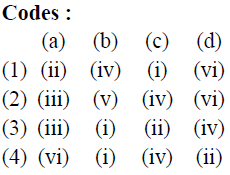
44. In a normal distribution, the plus one standard deviation corresponds to which percentile ?
(1) 34th
(2) 60th
(3) 84th
(4) 75th
45. Regarding a research hypothesis, which of the following combinations is not correct ?
A research hypothesis
a. is more specific than a problem statement.
b. is supported or not supported by theory.
c. is a statement including the participants of the study.
d. relates variables that can be measured, manipulated or categorized.
e. is the same as a statistical hypothesis.
Codes :
(1) a and b
(2) b and e
(3) c and e
(4) d and b
46. The Phi-Coefficient is related to tetrachoric ‘γ’ in the same manner as point – biserial is related to
(1) Contingency Coefficient (c)
(2) biserial (γ)
(3) Product moment (γ)
(4) Eta coefficient
47. In a study the significance of difference between means was tested through use of a ‘t’ test for a large group. The value of ‘t’ being 2.10, what will be the decision warranted in respect of H0 (Null hypothesis) ?
(1) The H0 will be retained.
(2) The H0 will be rejected at 0.01 level of significance.
(3) The H0 will be rejected at 0.05 level of significance only.
(4) The H0 will be rejected at both the levels of significance.
48. For use of a non-parametric test like the chi-square, which of the following assumptions has to be satisfied ?
(1) The data should arise from interval measures.
(2) The distribution has to be normal.
(3) No assumption about the nature of distribution is required.
(4) The variables under reference must be dichotomous.
49. A researcher finds out the relationship between three variables such as academic achievement, intelligence and socio-economic status of children using Pearson’s product moment ‘γ’. As per objective of his/her study the relationship between academic achievement and intelligence is also to be estimated by controlling the influence of socioeconomic status. Which statistical technique will be appropriate in this context ?
(1) Finding out multiple correlation
(2) Finding out correlation ratio
(3) Estimating contingency coefficient via chi-square
(4) Finding out partial correlation
50. For computation of ‘F’ value in one way Anova, what is the final procedural step ?
(1) Finding out the within sum of squares
(2) Finding out the between sum of squares
(3) Finding out the ratio of within and between sum of squares
(4) Finding out the ratio of between and within variance
Latest Govt Job & Exam Updates: